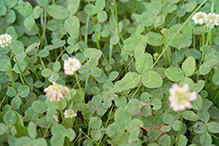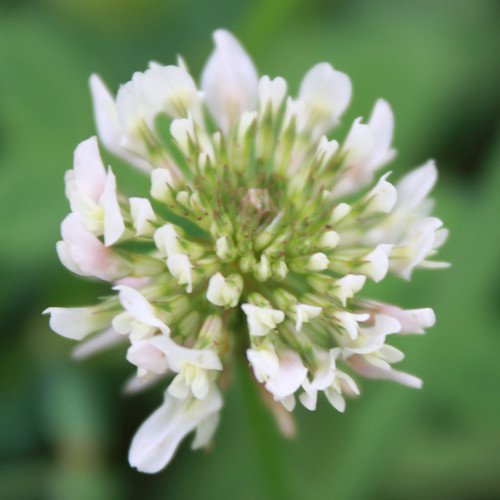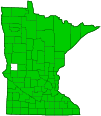white clover
(Trifolium repens ssp. repens)
Conservation • Wetland • Description • Habitat • Ecology • Use • Distribution • Taxonomy
Description |
||
White clover is a 4″ to 10″ tall, creeping, perennial forb that rises from a shallow, branching taproot and from rootlets formed by the creeping stem. It often forms colonies. The stems are light green, hairless and up to 1′ long. They creep along the ground and can root at the nodes. They send up leaves and flower heads on separate long stalks. The leaves are alternate and compound, divided into 3 leaflets. They are on hairless leaf stalks. The leaflets are elliptical, hairless, ⅜″ to ¾″ long and wide, and may have a shallow notch at the tip. They usually have a pale, crescent-shaped marking on the upper surface, though this may fade or be absent. The margins are finely-toothed. Flowers are borne in globular, head-like clusters at the end of long, unbranched, leafless, hairless stalks. The flowering stalks are usually taller than the leaves. The flower heads are ¼″ to ¾″ across. Each head has 20 to 50 flowers. The flowers are pea-like, with 5 petals organized into a banner, 2 wings, and a keel formed by two petals fused together at the tip. Each individual flower is borne on a short stalk. The petals are white and may be tinted with pink. They gradually turn brown as they age. The fruit is a seed pod containing 3 or 4 seeds. |
||
Height |
||
4″ to 10″ |
||
Flower Color |
||
White or white tinted with pink, never red; gradually turning brown |
||
Similar Species |
||
Alsike clover (Trifolium hybridum) is a much larger plant, 1′ to 2½′ tall. The stems are erect or ascending, not creeping, and they do not root at the nodes. Flowers and leaves are borne on the same branched stem. The leaflets have no markings on the upper surface and are not indented or pointed at the tip. The flower heads are more pink. Though not uncommon, it is much less common. Crimson clover (Trifolium incarnatum ssp. incarnatum) stems are densely hairy. The leaflets have no markings on the upper surface. The petals are crimson red. Red clover (Trifolium pratense) is a much larger plant, 1′ to 2½′ tall. The stems are hairy and do not root at the nodes. Flowers and leaves are borne on the same branched stem. The leaflets have a pale V-shaped marking on the upper surface and are not indented or pointed at the tip. The petals are pink or magenta. The individual flowers are stalkless. |
||
Habitat |
||
Disturbed sites, roadsides, lawns, trails. |
||
Ecology |
||
Flowering |
||
June to August |
||
Pests and Diseases |
||
|
||
Use |
||
|
||
Distribution |
||||
|
Sources |
|||
| 4/4/2023 | ||||
Nativity |
||||
Native to Northern Africa, Europe, Asia, and the Indian subcontinent. Introduced and naturalized in North America. |
||||
Occurrence |
||||
Very common |
||||
Taxonomy |
|||
| Kingdom | Plantae (Plants) | ||
| Subkingdom | Pteridobiotina | ||
| Phylum | Tracheophyta (Vascular Plants) | ||
| Class | Magnoliopsida (Dicots) | ||
Order |
Fabales (Legumes, Milkworts, and Allies) | ||
Family |
Fabaceae (Legumes) | ||
| Subfamily | Faboideae | ||
| Tribe | Trifolieae |
||
| Genus | Trifolium (Clovers) | ||
| Subgenus | Trifolium | ||
| Section | Trifoliastrum | ||
| Species | Trifolium repens (white clover) | ||
Subordinate Taxa |
|||
|
|||
Synonyms |
|||
Amoria repens Trifolium occidentale Trifolium repens var. biasolettii Trifolium repens var. giganteum Trifolium repens var. repens |
|||
Common Names |
|||
Dutch clover ladino clover white clover |
|||
Glossary
Axil
The upper angle where the leaf stalk meets the stem.
Visitor Photos |
|||||
Share your photo of this plant. |
|||||
| This button not working for you? Simply email us at info@MinnesotaSeasons.com. Attach one or more photos and, if you like, a caption. |
|||||
|
|||||
MinnesotaSeasons.com Photos |
|||||
Plant |
|||||
 |
 |
||||
Flower Head |
|||||
 |
 |
||||
Flowers |
|||||
 |
 |
||||
Leaves |
|||||
 |
 |
||||

Slideshows |
||
| Trifolium repens Susanne Wiik |
||

|
||
About
Hvitkløver, white clover |
||
| White Clover Wez Smith |
||

|
||
About
White Clover (Trifolium repens). |
||
| Trifolium repens Matt Lavin |
||

|
||
About
Introduced stoloniferous perennial herb, stems prostrate, leaflets serrate at least distally, terminal leaflet sessile like the lateral leaflets (which is true of all Trifolium species), flowering peduncles about 15 cm tall, pod 1-few-seeded, inconspicuous and concealed by the calyx, fruiting head retains the faded dry petals (which is true of all Trifolium species), common in lawns, fields, pastures, introduced as a cover crop. |
||
| White Clover Andree Reno Sanborn |
||

|
||
About
Trifolium repens |
||
| Trifolium repens WHITE CLOVER Frank Mayfield |
||

|
||

Visitor Videos |
|||
Share your video of this plant. |
|||
| This button not working for you? Simply email us at info@MinnesotaSeasons.com. Attach a video, a YouTube link, or a cloud storage link. |
|||
Other Videos |
|||
| White Dutch Clover (Trifolium repens) ~ LuminEarth's How to Identify Wild Edible & Medicinal Plants Becki Baumgartner |
|||
About
Uploaded on Oct 6, 2010 WARNING: Only use undamaged white clover plants when foraging. Damaged plants can contain a cyanogenic glycoside that can cause asphyxiation at the cellular level. The cyanogenic glycocide is not normally found in plants except when there has been plant injury from cutting, grazing, freezing or wilting. For this reason it is very important to make sure that you only use fresh, undamaged plants when foraging. This also means that you CANNOT ferment white clover flowers as the fermentation process will create cyanogenic acid. Appearance: Clovers have leaves in sets of three with a flower head ranging in color from white, cream to pinkish tinged. Harvesting: White Dutch Clover is found in lawns, fields, pastures, and disturbed areas. The young leaves are best harvested before the plant flowers. Edible: The flowers and leaves of White Dutch Clover are edible both raw and cooked. The flowers are the sweetest part of the plant. White Dutch Clover leaves are edible raw or cooked and can be used in salads, soups, casseroles, etc. Fresh or dried clover flowers make a delicious herbal tea. Clovers are legumes, so they provide a protein that compliment whole grains. I like to use the flower heads in stir-fry with rice, or in baking. Make sure to only use completely fresh leaves and flowers. Medicinal: An Infusion of White Dutch Clover flowers and leaves is good for detoxification and rebuilding. White clover was used ty The Cherokee, Iroquois and Mohegian Indians to purify blood and cleanse boils, sores, wounds, etc. White Clover is stimulating to the liver and gallbladder, and creates an overall strengthening and nourishing. Also used for gout, arthritis, skin disorders, and aids. Clover tea is used for bronchial coughs, whooping coughs and tuberculosis. The tea is also anti-inflammatory, calming, expectorant and antispasmodic. For the most current and detailed information on this plant, please visit our FREE Online Guide to Wild Edible & Medicinal Plants at http://www.luminearth.com/luminearthsguide/. Disclaimer: The statements in these videos are for educational purposes only and have not been evaluated by or sanctioned by the FDA. Only your doctor can properly diagnose and treat any disease or disorder. The remedies discussed herein are not meant to treat or cure any type of disease. The user understands that the above information is NOT intended as a substitute for the advice of a physician or a pharmacist. Make sure you can positively identify a plant before ingesting it. Some plants are poisonous, and misidentification could possibly result in serious illness or death. |
|||
| Weed Of The Week #789 - White Clover (Air Date 5/19/13) AgPhD's channel |
|||
About
Published on May 27, 2013 It's our Weed of the Week, White Clover (and just to clarify, a weed is defined, by us, as any plant that is growing where a grower determines it should not be growing). For example, if White Clover is growing where you desire only lawn grass, White Clover is a weed. |
|||
| White Clover Part 1 of 4 RichTheRidgeHunter |
|||
About
Published on Mar 16, 2012 Spring of the year before the bloom. This is part 1 of 4 on White Clover |
|||
| White Clover part 2 RichTheRidgeHunter |
|||
About
Published on Apr 18, 2012 Dry and grind the flower heads |
|||
| White Clover exposernine |
|||
About
Published on Jul 5, 2011 White Clover good edible plant. |
|||

Visitor Sightings |
|||||
Report a sighting of this plant. |
|||||
| This button not working for you? Simply email us at info@MinnesotaSeasons.com. Be sure to include a location. |
|||||
|
|||||
MinnesotaSeasons.com Sightings |
|||||
Avon Hills Forest SNA, North Unit Bertram Chain of Lakes Regional Park Blazing Star Prairie Addition Preserve, South Unit Carpenter St. Croix Valley Nature Center Charles A. Lindbergh State Park Clifton E. French Regional Park Felton Prairie SNA, Bicentennial Unit Forestville/Mystery Cave State Park John Peter Hoffman Spring Brook Valley WMA Minnesota Valley NWR, Louisville Swamp Unit Minnesota Valley NWR, Rapids Lake Unit Minnesota Valley State Recreation Area, Lawrence Unit Mound Spring Prairie SNA, North Unit Nerstrand Big Woods State Park Northern Tallgrass Prairie NWR, Rengstorf Unit Prairie Creek WMA, Koester Prairie Unit Robert Ney Memorial Park Reserve Sand Prairie Wildlife Management and Environmental Education Area Spring Beauty Northern Hardwoods SNA Stanley Eddy Memorial Park Reserve |
|||||

|
Created: Last Updated: © MinnesotaSeasons.com. All rights reserved. |
